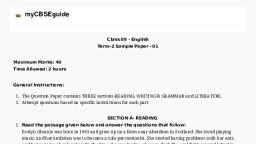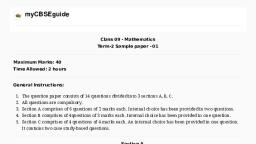Question 1 :
In an AP, given $a_{12} = 37, d = 3$, find a and $S_{12}$.
Question 2 :
The sum of the 4th and 8th terms of an AP is 24 and the sum of the 6th and 10th terms is 44. Find the first three terms of the AP.
Question 3 :
In an AP, given $a = 8, a_n = 62, S_n = 210$, find n and $d$.
Question 4 :
If the sum of first 7 terms of an AP is 49 and that of 17 terms is 289, find the sum offirst n terms.
Question 5 :
If the sum of the first n terms of an AP is $4n – n^2$, What is the nth term ?
Question 6 :
Find the number of terms in the following AP :18, 15.5, 13, . . . , – 47
Question 7 :
The first and the last terms of an AP are 17 and 350 respectively. If the common difference is 9, how many terms are there in the AP?
Question 8 :
The first and the last terms of an AP are 17 and 350 respectively. If the common difference is 9, what is the sum of the AP?
Question 9 :
<img style='object-fit:contain' src='https://teachmint.storage.googleapis.com/question_assets/cbse_ncert/61b19bc9273b230584979a16.JPG' />
In the above fig. A ladder has rungs 25 cm apart. The rungs decrease uniformly in length from 45 cm at the bottom to 25 cm at the top. If the top and the bottom rungs are $2\frac{1}{2}$ m apart, what is the length of the wood required for the rungs?
Question 10 :
Find the sum of the first 40 positive integers divisible by 6.
Question 12 :
Find the sum of the following AP: 0.6, 1.7, 2.8, . . ., to 100 terms.
Question 13 :
The houses of a row are numbered consecutively from 1 to 49. Show that there is a value of x such that the sum of the numbers of the houses preceding the house numbered x is equal to the sum of the numbers of the houses following it. Find this value of x.
Question 14 :
The 17th term of an AP exceeds its 10th term by 7. Find the common difference.
Question 15 :
Find the sum of the odd numbers between 0 and 50.
Question 16 :
<img style='object-fit:contain' src='https://teachmint.storage.googleapis.com/question_assets/cbse_ncert/61b19bc9273b230584979a17.JPG' />
A small terrace at a football ground comprises of 15 steps each of which is 50 m long and built of solid concrete. Each step has a rise of 0.25 m and a tread of 0.5 m. Calculate the total volume of concrete required to build the terrace.
Question 17 :
If the 3rd and the 9th terms of an AP are 4 and – 8 respectively, which term of this AP is zero?
Question 18 :
If the sum of the first n terms of an AP is $4n – n^2$, What is the 10th term ?
Question 19 :
Find the sum of the following AP: 34 + 32 + 30 + . . . + 10
Question 20 :
30th term of the AP: 10, 7, 4, . . . , is
Question 21 :
Determine the AP whose third term is 16 and the 7th term exceeds the 5th term by 12.
Question 22 :
Find the sum of first 51 terms of an AP whose second and third terms are 14 and 18 respectively.
Question 23 :
If the sum of the first n terms of an AP is $4n – n^2$, what is the first term (that is $S_1$)?
Question 24 :
Two APs have the same common difference. The difference between their 100th terms is 100, what is the difference between their 1000th terms?
Question 25 :
The first term of an AP is 5, the last term is 45 and the sum is 400. Find the number of terms and the common difference.
Question 26 :
11th term of the AP: – 3, -0.5, 2, . . ., is
Question 27 :
Find the sum of the following AP: –5 + (–8) + (–11) + . . . + (–230)
Question 28 :
In an AP, given $a_n = 4, d = 2, S_n = –14$, find n and a.
Question 29 :
Find the 31st term of an AP whose 11th term is 38 and the 16th term is 73.
Question 30 :
How many terms of the AP : 9, 17, 25, . . . must be taken to give a sum of 636?
Question 31 :
<img style='object-fit:contain' src='https://teachmint.storage.googleapis.com/question_assets/cbse_ncert/61b19bc7273b230584979a14.JPG' />
In the above fig. 200 logs are stacked in the following manner: 20 logs in the bottom row, 19 in the next row, 18 in the row next to it and so on. In how many rows are the 200 logs placed and how many logs are in the top row?
Question 33 :
<img style='object-fit:contain' src='https://teachmint.storage.googleapis.com/question_assets/cbse_ncert/61b19bc3273b230584979a0e.JPG' />
In the above fig, find the missing value corresponding to (iii)
Question 34 :
A contract on construction job specifies a penalty for delay of completion beyond a certain date as follows: Rs 200 for the first day, Rs 250 for the second day, Rs 300 for the third day, etc., the penalty for each succeeding day being Rs 50 more than for the preceding day. How much money the contractor has to pay as penalty, if he has delayed the work by 30 days?
Question 35 :
In the following AP, find the missing term: 2, __ ,26
Question 36 :
Find the 20th term from the last term of the AP : 3, 8, 13, . . ., 253.
Question 37 :
In an AP, given a = 5, d = 3, $a_n$= 50, find n and $S_n$.
Question 38 :
Find the sum of the first 15 terms in $a_n = 3 + 4n$.
Question 40 :
In a school, students thought of planting trees in and around the school to reduce air pollution. It was decided that the number of trees, that each section of each class will plant, will be the same as the class, in which they are studying, e.g., a section of Class I will plant 1 tree, a section of Class II will plant 2 trees and so on till Class XII. There are three sections of each class. How many trees will be planted by the students?
Question 41 :
In an AP, given $a = 2, d = 8, S_n = 90$, find n and $a_n$.
Question 42 :
An AP consists of 50 terms of which 3rd term is 12 and the last term is 106. Find the 29th term.
Question 43 :
Does $a_1, a_2, . . ., a_n, . . $ form an AP where $a_n = 9 – 5n$?
Question 44 :
Which term of the AP : 3, 15, 27, 39, . . . will be 132 more than its 54th term?
Question 45 :
If the sum of the first n terms of an AP is $4n – n^2$, What is the 2nd term ?
Question 46 :
Check whether – 150 is a term of the AP : 11, 8, 5, 2 . . .
Question 47 :
Find the sum of the following AP: –37, –33, –29, . . ., to 12 terms.
Question 48 :
In an AP, given $a = 3, n = 8, S = 192$, find d.
Question 49 :
Ramkali saved Rs. 5 in the first week of a year and then increased her weekly savings by Rs. 1.75. If in the nth week, her weekly savings become Rs. 20.75, find n.
Question 50 :
A sum of Rs. 700 is to be used to give seven cash prizes to students of a school for their overall academic performance. If each prize is Rs. 20 less than its preceding prize, find the smallest value of the prize.























